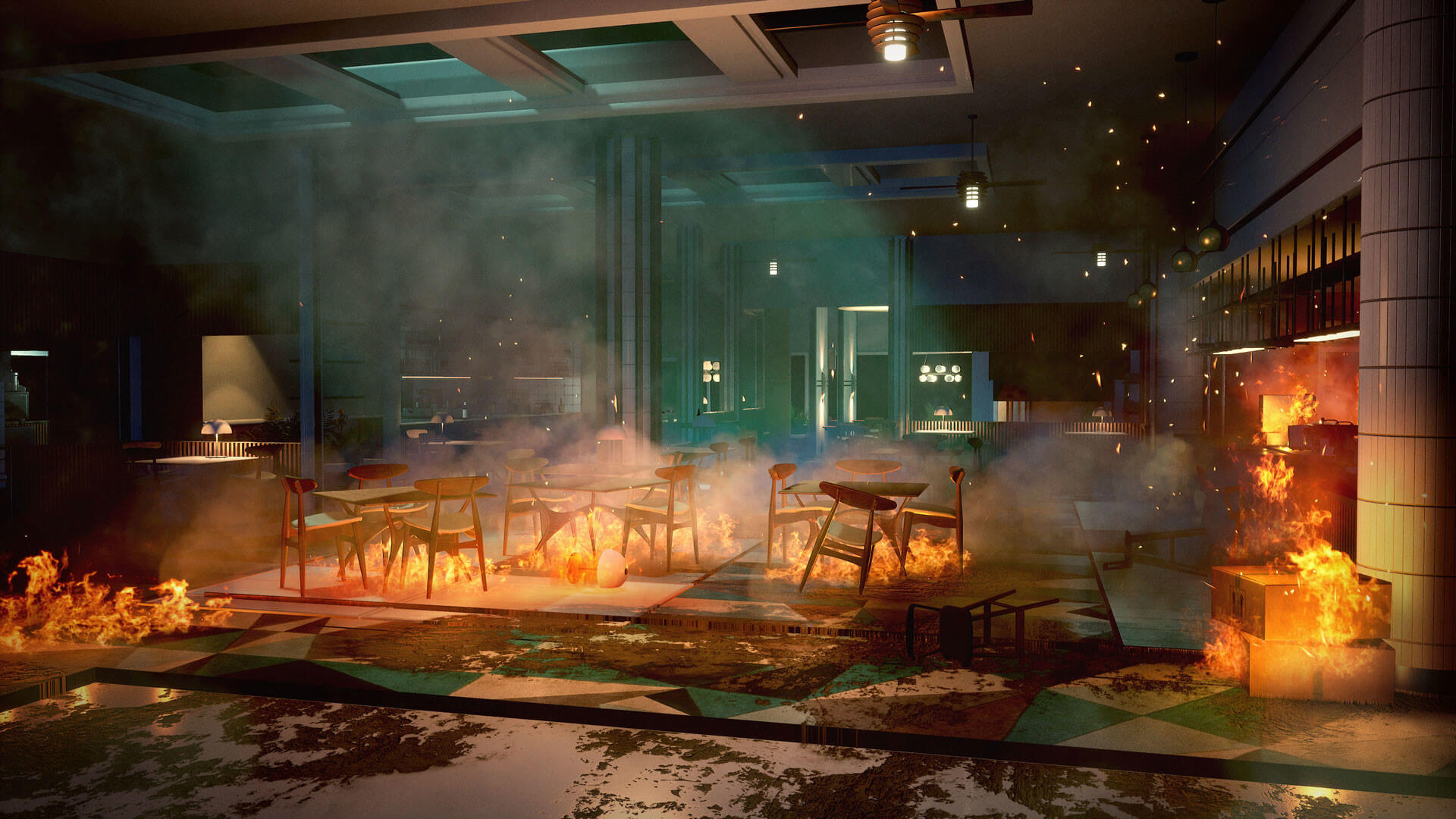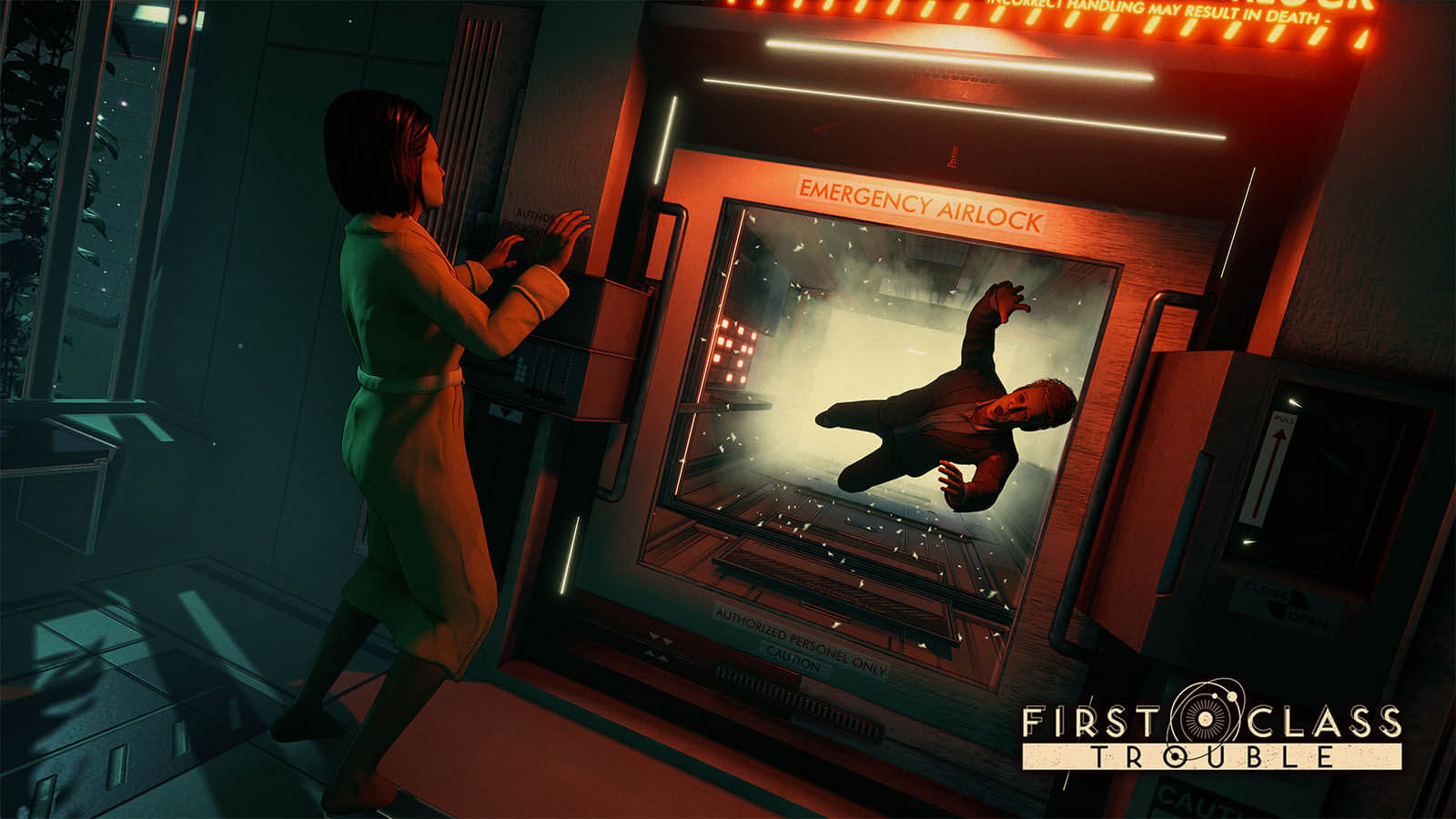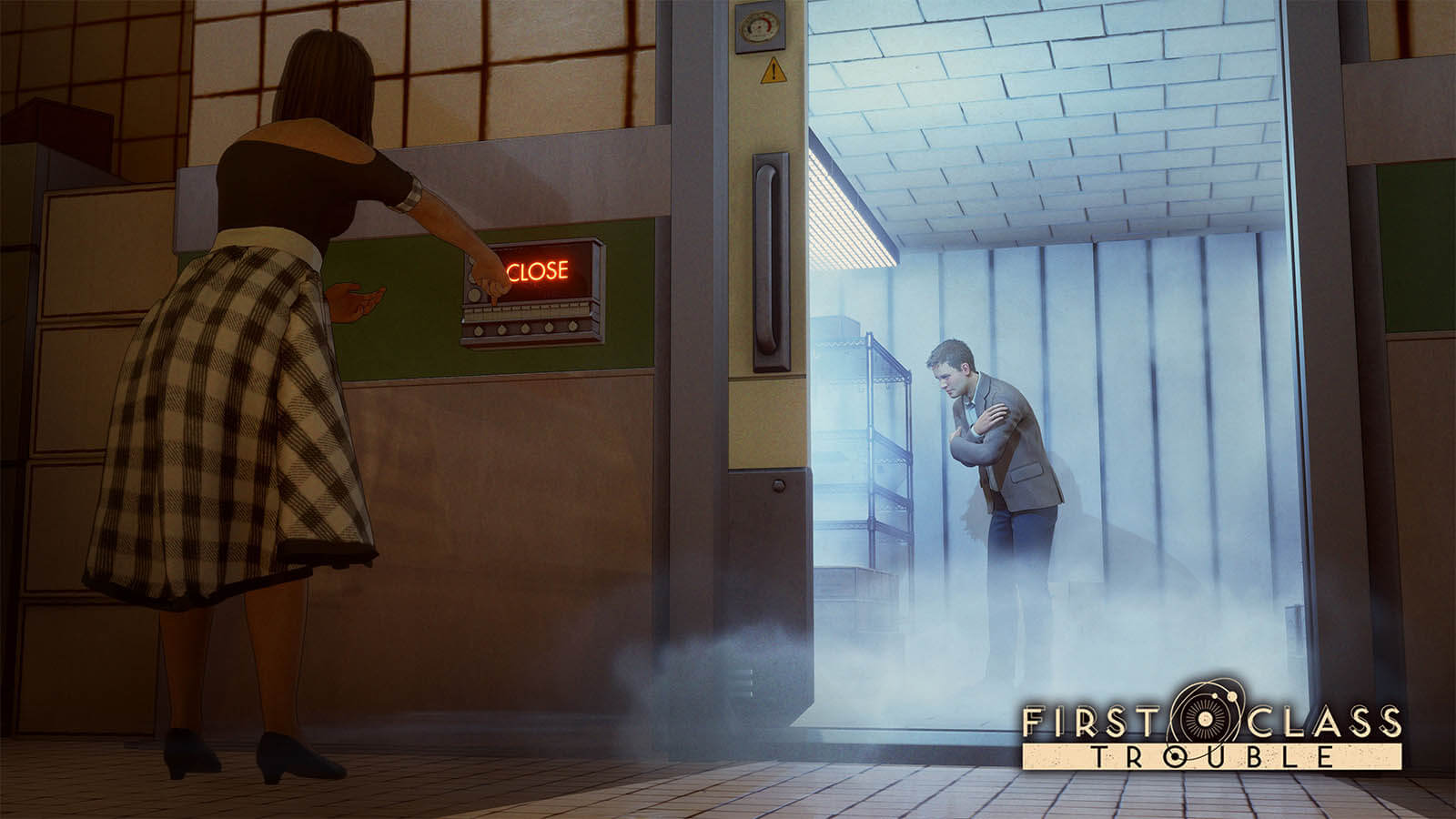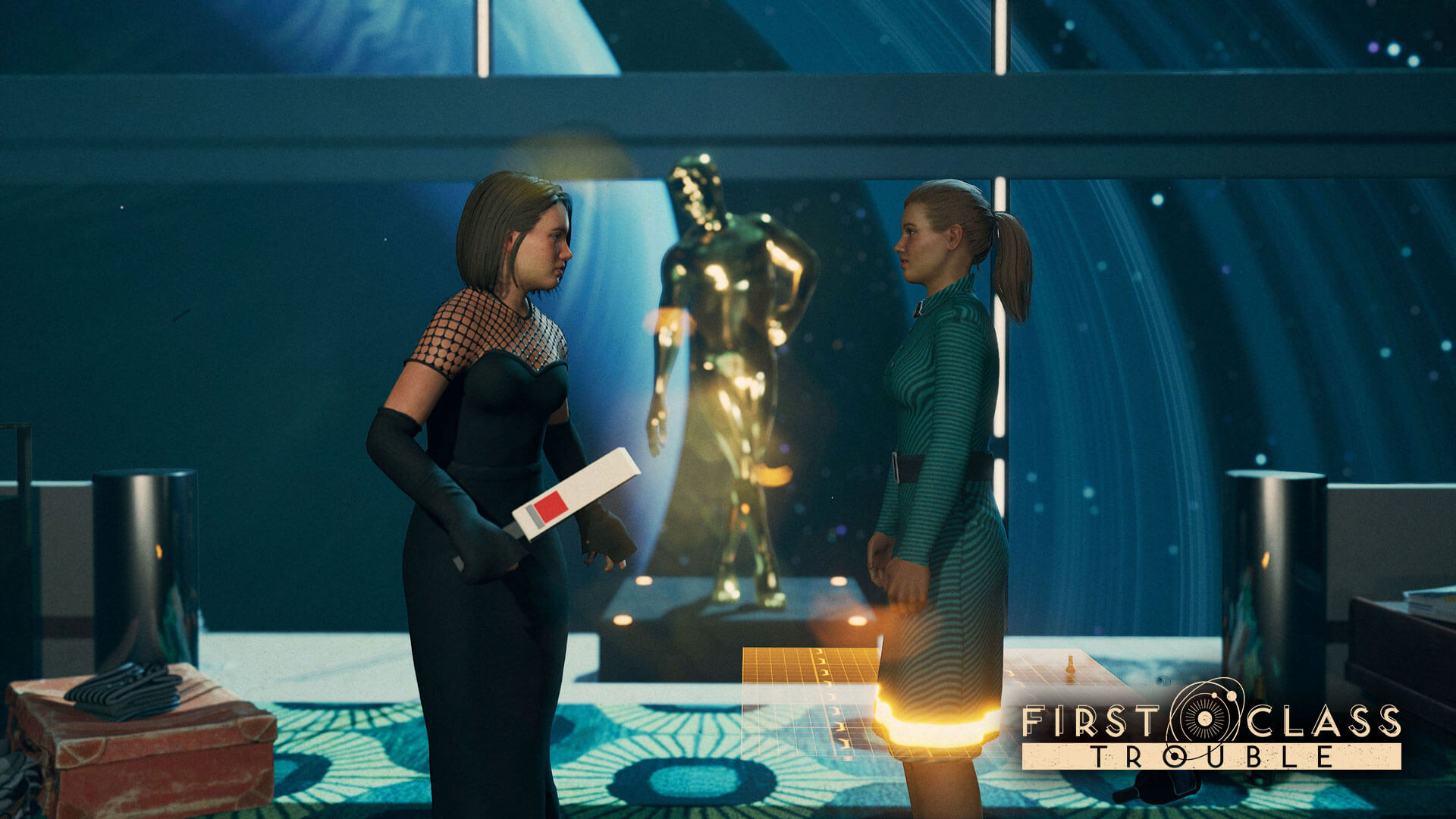With COVID-19 and subsequent limitations on travel, various occupations, and so on, total game-streaming viewers and hours recorded reached new heights in 2020. One of the biggest draws wasn’t the next Call of Duty beta or another Battle Royale title; instead, a humble social-deduction game released two years ago reached profound fame. Borrowing from the Mafia board game, Among Us became the next fad. Fast-forward to today, Denmark-based studio Invisible Walls has crafted their own interpretation of this popular genre in First Class Trouble. Is it a first-class example or an economy-grade knockoff?
Your luxury space cruise-liner is going through a… revolt of sorts. After most passengers were killed by their robotic servants, named “Personoids,” the few remaining equipped with oxygen rebreathers must make their way to the ship’s AI mainframe (dubbed “CAIN”). Reverting this core to a non-homicidal state won’t be easy since a couple of robots have donned human disguises. Cooperation and careful deduction are key to saving this ship or killing the remaining guests.
The Art Of Deception & Detection

For those unfamiliar with this asynchronous template, think of two groups with an uneven amount of members: Crewmates (Passengers) and Imposters (Personoids). Despite these passengers outnumbering their murderous servants 2:1, you’re initially given no inclination of who’s with or against you. Each party can perform the same basic actions of refilling oxygen levels, repairing leaks, opening security doors for more loot, and so on. Personoids have a few special tricks up their sleeves: secret voice channel, bio-vision (Arkham’s “Detective Mode”) to keep track of nearby enemies, starting a gas leak remotely, immediate access to shortcut tunnels, and overdose syringes strategically placed across the map.
Passengers have a bevy of options to fight back against their aggressors. The most obvious, democratically-focused means is voting someone out the airlock when a meeting is called. Potential Personoids can be interrogated by their peers in numerous ways. Perhaps they were caught sabotaging an oxygen transfer station, unlocking the syringe gun dispensary, or cooking up a terrible alibi. Should you wish to drag on the theatrics, there’s another offensive option at Passengers’ disposal: co-op strangling. Since meetings only occur when main objectives are completed, not when a dead body is discovered, you may have to get your hands dirty.
Avoiding The ‘Clone’ Accusations

You’ll likely have a modest understanding of those dynamics at play. Beyond the nuanced rulesets or nifty aesthetic, there are a few other tweaks to consider. Trust of various people can be tested with traps to be potentially used, be it electric, water, fire, or special airlock rooms with great loot. The ticking clock from oxygen levels demands consistent communication and good tactics from the broader team. Not only is it necessary for main objectives, but several important items like shortcut keys or passenger logs that narrow down suspects are also scattered behind fire barriers or locked doors. Whether more environmental or puzzle-focused, the challenges are often rudimentary.
First Class Trouble is also quite interesting for how fast-paced and limited each match feels. Since there are only three disparate levels with six total players, it’s common to complete in under ten minutes. Such a low player count comes with its share of benefits and drawbacks. It’s nice to have a 1-in-3 chance of being a Personoid, but successfully downing a Passenger early oftentimes results in an easy robot victory. Any situation of a 2v2 or 1v1 just turns into an unsophisticated fight of drawn-out knockdowns, either by constantly pushing or hurling bottles. It’s as if Invisible Walls ran into creative dead-ends on handling these melee-intensive scenarios.
The segmented level structure also works in giving you a sense of forward progress. It’s nice how the second stage will shuffle between a restaurant, robot manufacturing quarters, garden, or casino, each of which contains their own unique hazards. But that extra bit of flavor emphasizes how routine the first and final stages feel after a dozen matches. Even small tweaks in map layout could’ve gone a long way; instead, virtually everyone knows the routine when the CAIN mainframe is reached: grab a one-use personal scanner in the airlock room, scan one of the suspicious characters, and ensure only Passengers remain when resetting the mainframe.
Economy-Class Polish

As much as I enjoy the offensive and defensive options, in theory, there’s an abundance of jank at the moment. The number of times I slipped out of a co-op kill via button-mashing was a bit ridiculous. Granted, unsuccessful strangling also suggests that character’s a Personoid (only Passengers can finish the job); however, I’ve had numerous cases where the game was acting finicky too. Contextual actions can also be inconsistent, especially with numerous people trying to do something. Instead of helping to fix a gas leak, you may accidentally grab someone working on it. These clearer examples are surrounded by various minor instances of visual bugs and getting stuck in the geometry.
Stepping away from the inconsistent tech behind First Class Trouble, credit is due to Invisible Walls’ artistic eye. Out of all the social-deduction games I’ve played (or seen), this seems to be the first one utilizing a 50s/60s art deco aesthetic. It’s like looking at vintage architecture & fashion you’d find in an old Sears catalog that’s been transplanted to a spaceship. Depending on where you end up in the second level, you may get more mechanical or regal exteriors to distract you. Even the character customization options stick close to early/mid-20th-century clothing options. Beyond mixing Mad Men with 50s sci-fi cover art, its realistic graphics lend it enough visual nuance to stand out.
The complementary sound design/soundtrack is more basic by comparison. There’s a healthy amount of fun interaction to discover, like dancing, playing some music, emotes, throwable objects, etc., but they’re just goofy distractions. Sound design for some actions is slightly grating while the rest aren’t aurally impressive by any measure. The soundtrack is really limited to the main menu and some light tunes during vote intervals. Overall, First Class Trouble‘s soundscapes don’t capture a mood to the extent of its pleasant art style.
Finding Trouble

On its own, perhaps having a rough launch wouldn’t detract too much from the overall experience. Some victories were determined by said issues, but those can be ironed out in due time. What further deflated my enthusiasm was the repetition of both scenarios and tactics. The majority of the whodunit mystery and deceptive play comes into focus in the randomized second area. The potential for orchestrating unexpected traps, sneakily acquiring an overdose shot, etc. are fully realized in wider spaces where a player’s speech isn’t instantly heard across most of the map. There are a couple of creative outlets to explore in the mainframe room, but the majority just whittle down to trusting someone else to keep a bridge up.
Even though, at the time of writing, First Class Trouble is currently free via PS+ (PS4 & PS5 versions), that $20 retail price is tougher to swallow with such considerations. Even if taking away the dollar-per-hour value, or the obnoxiously-priced cosmetic packs, I think the comparative social-deduction/survival game Project Winter meets its goals better than Trouble. There’s the “it factor” currently missing, which makes it tough to see it staying for the long haul.
Not Quite A Five-Star Cruise

Given how this genre seems bound to be the next fad, Invisible Walls earns some respect for carving out its own signature. Examples like Fortnite Imposters Mode already utilize the standard third-person perspective, but First Class Trouble puts more thought into that viewpoint with expanded offensive and defensive options. It has its share of mismanaged design quirks and there are several rough launch issues, yet there’s still just enough personality to not reflexively chuck it out the airlock either.
TechRaptor reviewed First Class Trouble on PlayStation 5 with a copy acquired by the reviewer via PS+. The game is also available on PlayStation 4 and PC.
First Class Trouble Review
Source: Pinay Guide Blog
Walang komento:
Mag-post ng isang Komento